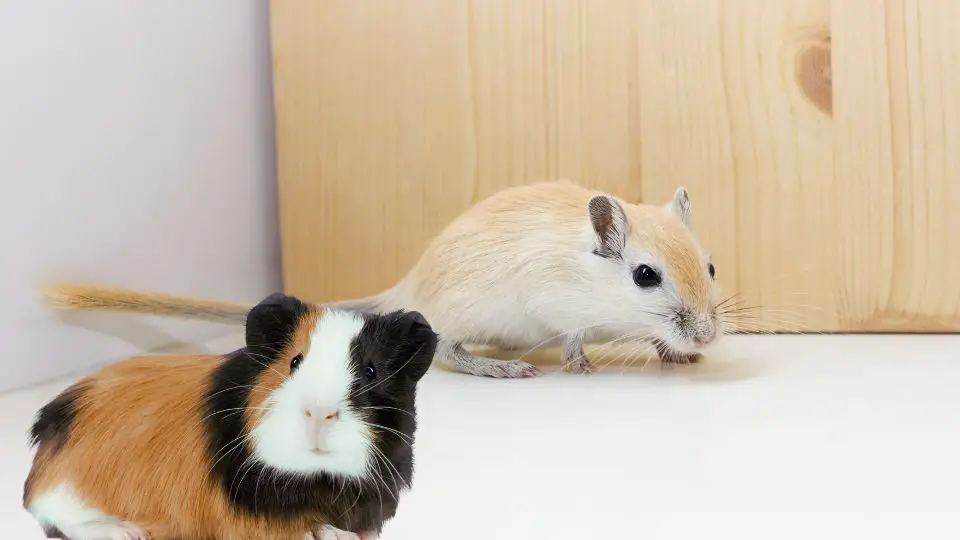When it comes to our furry friends, understanding their senses and abilities is essential for providing them with optimal care. One aspect of gerbil physiology that often piques curiosity is their eyesight.
Yes, gerbils have relatively good eyesight. While their vision may not be as sharp or far-reaching as some other animals, they have adapted well to their natural environment.
In this article, we will delve into the question of whether gerbils have good eyesight.
Do Gerbils Have Good Eyesight?
Yes, gerbils have relatively good eyesight. While not as sharp as that of some other animals, their vision is well-suited for their natural behaviors and environment. Gerbils can perceive details, recognize objects, and navigate their surroundings effectively.
They have a wide field of view due to the positioning of their eyes on the sides of their head, allowing them to be more aware of potential threats or predators from different directions.
However, gerbils are considered to be nearsighted, which means their ability to see objects clearly at a distance may be somewhat limited. Nevertheless, their eyesight is well-adapted to support their active and inquisitive nature.
Anatomy of Gerbil Eyes
The eyes are remarkable organs that play a vital role in a gerbil’s perception of the world around them.
Eye Structure
Gerbils have two eyes positioned on the sides of their head, allowing for a wide field of view. Each eye consists of several key components, including:
- Cornea: The transparent outermost layer that covers the front of the eye, helping to focus incoming light.
- Iris: The colored part of the eye that controls the size of the pupil, regulating the amount of light that enters.
- Pupil: The black circular opening in the center of the iris that expands or contracts to control the amount of light reaching the retina.
- Lens: A flexible structure located behind the iris that helps to focus light onto the retina.
- Retina: A thin layer at the back of the eye containing specialized cells that convert light into electrical signals for the brain to interpret.
- Optic Nerve: Connects the retina to the brain, transmitting visual information.
Eye Shape and Position
Gerbils have eyes that are rounded and slightly protruding. This shape allows for a wider field of view, aiding in detecting potential predators or threats from various directions. The position of their eyes on the sides of their head provides them with a panoramic view, but their depth perception may be slightly limited compared to animals with forward-facing eyes.
Adaptations for Nocturnal Vision
As primarily nocturnal creatures, gerbils have specific adaptations that enhance their vision in low-light conditions. Their eyes are equipped with a high density of rod cells, which are more sensitive to dim light. This allows them to navigate their burrows and explore their surroundings during nighttime activities. However, their reliance on rod cells for vision may result in reduced color perception compared to animals with a greater abundance of cone cells.
Visual Acuity and Range
Gerbils are curious and active creatures that rely on their vision to navigate their environment and interact with the world around them.
Visual Acuity
Gerbils possess a reasonably good level of visual acuity, allowing them to perceive details in their surroundings. While not as sharp as the vision of some other animals, gerbils are still adept at detecting movement, recognizing objects, and assessing their environment.
This level of acuity enables them to navigate their burrows and forage for food effectively. However, it is important to note that gerbils are considered nearsighted, meaning their ability to see objects clearly at a distance may be somewhat limited.
Color Perception
Gerbils have the ability to distinguish between certain colors. Although their color perception may not be as vibrant as that of humans, they can still differentiate various shades. It is believed that gerbils have a reduced range of color perception compared to animals with more cone cells specialized for color vision.
Nevertheless, they can appreciate and respond to color cues in their environment, which adds to their sensory experience.
Range of Vision
Gerbils possess a wide field of view, thanks to the positioning of their eyes on the sides of their head. This arrangement grants them a panoramic perspective, allowing them to be more aware of potential threats or predators approaching from different angles.
While their field of view is expansive, gerbils’ depth perception may be slightly limited due to their eyes’ positioning. However, they compensate for this through their acute sense of hearing and their ability to rely on other senses, such as touch, to gauge distances accurately.
Understanding the visual acuity and range of gerbils provides insights into how they perceive their surroundings and interact with their habitat. It also aids in creating an enriching environment that supports their natural behaviors and sensory experiences.
Nocturnal Nature and Adaptations
Gerbils are fascinating creatures that have adapted to thrive in dimly lit environments, as they are primarily nocturnal animals.
Nocturnal Lifestyle
Gerbils are most active during the night, utilizing the cover of darkness to engage in foraging, exploration, and social interactions. Their nocturnal behavior allows them to avoid daytime predators and find resources in the relative safety of darkness.
Eye Adaptations
To accommodate their nocturnal lifestyle, gerbils have developed several adaptations that enhance their vision in low-light conditions. Their eyes are equipped with a higher density of rod cells, which are more sensitive to light and motion. This increased number of rod cells allows gerbils to detect even subtle movements and navigate their surroundings with precision.
Sensitivity to Motion
Gerbils have an exceptional ability to detect motion, making them highly responsive to changes in their environment. Their eyes are finely tuned to pick up even the slightest movement, providing them with an early warning system against potential threats. This heightened sensitivity helps them stay alert and avoid predators during their nighttime activities.
Despite the limited amount of light available at night, gerbils possess the remarkable ability to navigate their surroundings effectively. Their heightened sensitivity to motion, combined with a keen sense of hearing and well-developed whiskers, enables them to move confidently through their burrows and explore their environment with agility.
Visual Communication and Behaviors
Gerbils are social animals that rely on a variety of communication methods to interact with each other and their environment. Visual communication, which includes body language and eye contact, plays a significant role in their social dynamics and daily interactions.
Body Language and Eye Contact
Gerbils employ subtle body language cues to convey messages to their fellow gerbils. One essential aspect of this communication is eye contact. Maintaining eye contact can signal friendliness, curiosity, or even dominance among gerbils. However, prolonged or intense eye contact can be interpreted as a challenge or threat.
Grooming
Grooming is an essential social behavior for gerbils that helps establish and reinforce social bonds. When gerbils groom each other, they use their eyes to maintain contact and establish trust. The grooming process involves gentle nibbling and licking, accompanied by reciprocal eye contact, creating a sense of connection and security within the group.
Play Behavior
Gerbils engage in play as a way to interact and bond with their companions. During play, gerbils exhibit energetic movements and often make direct eye contact with their playmates. Playful eye contact conveys a sense of engagement, enjoyment, and a willingness to participate in friendly activities.
Territorial Displays:
Gerbils are known to be territorial animals, and they use visual cues, including eye contact, to establish and defend their territories. Direct eye contact between gerbils may serve as a warning or a way to assert dominance. Such displays communicate boundaries and help maintain order within their social structure.
Potential Limitations or Deficiencies
Gerbils are remarkable creatures with a variety of unique adaptations, including their eyesight. While their vision serves them well in their natural habitats, you have to be aware of potential limitations or deficiencies that may affect their visual capabilities.
Nearsightedness
One limitation of gerbil eyesight is their tendency to be nearsighted. This means they may have difficulty seeing objects clearly at a distance. Gerbils have evolved to focus more effectively on objects that are closer to them, such as their food, nesting materials, or fellow gerbils within their immediate surroundings. While their nearsightedness may impact their ability to see far-off objects in detail, it doesn’t hinder their overall ability to navigate their environment.
Eye Diseases
Gerbils, like any living beings, are susceptible to certain eye diseases that can impact their vision and ocular health. One common eye condition seen in gerbils is conjunctivitis, characterized by redness, swelling, and discharge in the eye area. Another condition that can occur is the formation of cataracts, which can lead to cloudy vision. Regular observation of your gerbil’s eyes and prompt veterinary care are essential for early detection and appropriate treatment of any eye diseases that may arise.
Sensitivity to Light
Gerbils have adapted to their natural nocturnal lifestyle, and as a result, they may be more sensitive to bright or direct light. Excessive exposure to bright light can cause discomfort and may even temporarily impair their vision. It’s crucial to provide appropriate lighting in their habitat, ensuring a balance between light and darkness to support their visual comfort and well-being.
FAQ
How well do gerbils see?
Gerbils have relatively good eyesight, allowing them to perceive details in their surroundings. While not as sharp as that of some other animals, their vision enables them to detect movement, recognize objects, and navigate their environment effectively. However, gerbils are considered to be nearsighted, which means their ability to see objects clearly at a distance may be somewhat limited.
Can gerbils see in the dark?
Yes, gerbils have adapted to see in low-light conditions and can navigate their surroundings effectively during the night. Their eyes have a higher density of rod cells, which are more sensitive to dim light. This adaptation allows them to move and forage in their burrows and explore their environment even in the absence of bright light.
Do gerbils recognize their owners?
While gerbils may not recognize their owners in the same way that dogs or cats do, they can develop a bond and familiarity with their human caretakers. Over time, gerbils can become accustomed to their owners’ presence, associate them with positive experiences such as feeding and handling, and display signs of recognition through their behavior and interactions.
Can gerbils see UV light?
Gerbils, like many other mammals, do not have the ability to see UV (ultraviolet) light. Their vision is primarily focused on perceiving visible light wavelengths. UV light is beyond the range of their visual spectrum, and they do not possess the necessary visual receptors to detect it.
Conclusion
In conclusion, gerbils have well-adapted eyesight that allows them to navigate their surroundings and interact with their environment effectively. While their vision may not be as sharp or far-reaching as some other animals, gerbils have developed specialized visual adaptations to suit their specific needs as burrowing, nocturnal creatures.
Their nearsightedness, heightened sensitivity to motion, and ability to navigate in dim light contribute to their survival and well-being







